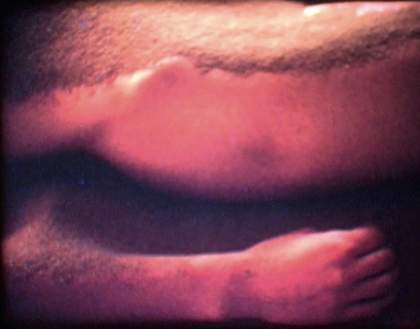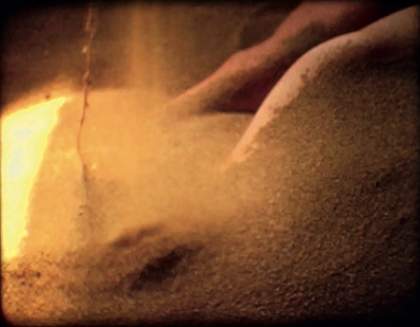
Still from Barry Flanagan’s Super 8mm film sand girl 1970
© Estate of Barry Flanagan, courtesy Plubronze Ltd
‘Dear Mr. Caro, I may not have been a good student… merely a passionate one,’ wrote artist Barry Flanagan in 1963 to his Central Saint Martins tutor, the renowned sculptor Anthony Caro. Flanagan would go on to reject the formalist principles embodied in his tutor’s monumental steel sculptures and seek instead to exemplify the oppositional strategies of ephemerality and fluidity in the artworks he created across a remarkably diverse range of media – including poetry, music, sculpture, performance and film. Most frequently associated with the bronze hares he produced in the 1980s, his significant accomplishments in other media have, until recently, been largely overlooked.
Between 1968 and 1972 Flanagan began experimenting with film and the effects of light projection, producing approximately 10 moving image works during the period. All but three of the films appear to have been lost or destroyed.

Still from Barry Flanagan’s Super 8mm film sand girl 1970
© Estate of Barry Flanagan, courtesy Plubronze Ltd
Made in his south London studio, sand girl, which was bought by Tate in 2012, used one of his fellow art students, Cheryll Potter, as its model. The 8mm silent colour movie features a naked Potter lying on Flanagan’s studio floor beneath a hanging rope. ‘He hooked a bag of sand on to it,’ she explains, ‘and then took a large knife… cut a hole in the bag of sand and started to swing it over my body. He then took out a Super 8 movie camera and started to film the event.’ At the very end, according to Potter, Flanagan instructed her to get up slowly so that he could film the sand (a recurring material in his sculptural works) as it fell away from her body, leaving an imprint on the floor.

Still from Barry Flanagan’s Super 8mm film sand girl 1970
© Estate of Barry Flanagan, courtesy Plubronze Ltd
Although still often characterised as a sculptor, recognising the importance of Flanagan’s moving image works helps us to appreciate why film historian David Curtis stresses the artist’s key influence on the explosion of UK avant-garde filmmaking that emerged from Central Saint Martins and elsewhere in the late 1960s and 1970s.
